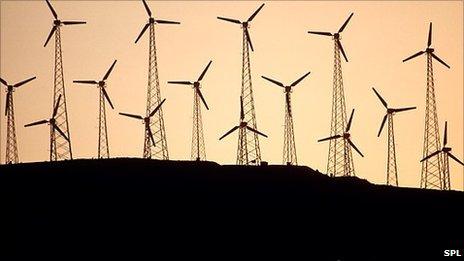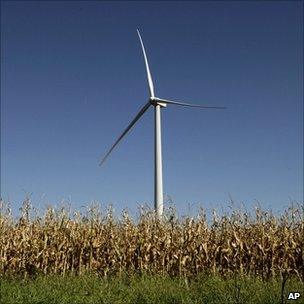Wind farms can affect local weather patterns
- Published

One of the solutions would be changing the rotor design
Wind farms, especially big ones, generate turbulence that can significantly alter air temperatures near the ground, say researchers.
As turbines often stand on agricultural land, these changes could in turn affect crop productivity.
In the journal Proceedings of the National Academy of Sciences (PNAS), the team says the impact could be reduced by changing rotor design.
Another option would be to site farms in areas with high natural turbulence.
The world's very first wind farm was set up in southern New Hampshire, US, in 1980.
Almost a decade later, in 1989, a meteorological field study conducted on a wind farm in San Gorgonio, California, gathered temperature data over a period of almost two months.
This data formed the basis of the current study, external.
The team, led by Somnath Baidya Roy from the University of Illinois, analysed the information - seemingly, "the only meteorological field campaign conducted in an operational wind farm".
The scientists also conducted multiple computer simulations of a wind farm using a climate model called RAMS (Regional Atmospheric Modeling System).
The research showed that, depending on the natural air conditions, mixing the air with a turbine's rotor would either result in a warming or a cooling near the surface.

Crops grown around turbines could be affected
"This turbulence leads to a warming near the surface at night and a cooling during the day," Dr Roy told BBC News.
He added that the effects were in the range of ‐0.4 to 1.5C.
To reduce this turbulence effect and therefore the impact on the ground temperature, the authors suggest two possible solutions.
One is changing the rotors - possibly a rather expensive strategy, but, argue the scientists, "designing new rotors that generate less turbulence in their wakes also increases the productivity of wind farms".
And the second tactic would be moving the wind farm in question to a different site, with high natural turbulence.
Fossil fuels
But Jonathan Scurlock, chief adviser on climate change and renewable energy at the National Farmers Union, said that using wind energy was "one of many measures, which can be [used] to mitigate climate change".
"The major threats to agriculture in terms of changing the air temperature come directly from the fossil fuel industry and deforestation, increasing CO2 concentration in the atmosphere," he added.
"Farmers have got far more to fear from … well-known climatic processes driven by fossil fuel emissions than anything that is going to come as a consequence of deploying wind power."
But Dr Roy noted that even though wind farms were unlikely to have an effect on global climate change, "the impacts on local climate can be large".
He also said that the study was not about comparing wind power to any other technology, but about considering and addressing possible side effects of this green energy.
"Wind energy is likely to be a part of the solution of the global warming problem," he said.
"Often, in a rush to implement new technologies, we ignore possible side‐effects that may show up in the future.
"As a strong proponent of renewable energy, I am interested in making sure that the technology is properly implemented, [to ensure] long term sustainability of wind power by helping operators and utility companies to indentify impacts of wind farms on local weather and if necessary, take appropriate steps to mitigate these effects."
- Published27 September 2010
- Published7 September 2010
- Published17 August 2010